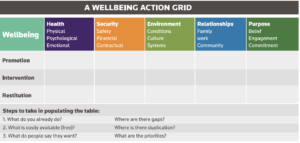Two themes that have typified the Covid-19 pandemic have been uncertainty, and significant changes to the way we live our lives. People across the world have been dealing with grief, fear of illness, isolation, reduced income, changes in working patterns, lack of connection and blurred boundaries between work and home.
Employment has always played an important role in driving our wellbeing and mental health – whether through self-identity, financial security, our sense of purpose or the quality of our relationships – and during the crisis, for many, this role is now critical.
What works to support employees?
In order to support employee wellbeing, companies often run a series of disjointed initiatives, rather than develop an evidence-based strategy. Whilst lots of wellbeing initiatives can have a good impact on their own, the evidence is clear that where they are integrated into wider systems and are part of a strategy they can be most effective.
Here at the What Works Centre for Wellbeing, we developed a model based on our work with businesses to address workplace wellbeing.
It is a simple framework of the five key drivers of wellbeing that can be continually developed with sub-themes and concepts as outlined below. Of course, health is important but all five are important and affect one another, so together they can be a powerful combination.

Knowing how the drivers of wellbeing play out within each context informs what action you take – as demonstrated by the multi-site wellbeing programme that was rolled out by a Ministry of Defence business unit.
The model above is a good starter, particularly if used alongside this action plan to help identify any areas of focus or potential gaps in an existing programme.

Using this grid will help to differentiate the types of action your organisation does. In developing your plan, get more specific in what you offer, considering the different elements under each of the driver areas. The grid should be populated considering each key driver in turn, taking into account the following questions:
- What do we already do?
- What is easily available?
- What do people say they want?
- Where are there gaps?
- Where is there duplication?
- What are the priorities?
Wellbeing Action Plan Toolkit
There are two particular areas of the model that have been more deserving of attention during the pandemic:
Purpose, belonging and identity
A key driver of personal wellbeing comes from the feeling that life has meaning and purpose, that the things we do are worthwhile. Whilst this can be found in many aspects of life, work is one of the main sources of it for many people.
Dr Brendan Burchell from Cambridge University, explains the importance of work, beyond income:
“As social scientists have found repeatedly, in different countries and different demographic groups, the loss of the wage only explains a small fraction of the very large mental health deficit associated with unemployment and economic inactivity.”
Time structure, enforced activity, social contact, collective purpose, status and identity are other crucial experiences that we get from paid employment.
The Centre’s review of the evidence found that workplaces which had been hit by the 2008 recession, but where employees had a strong sense of organisational identity were:
- More than four times more likely to have withstood negative effects of the recession on employee wellbeing than workplaces with a weak sense of identity.
- Almost four times more likely to have maintained high levels of organisational performance.
How do we maintain a sense of purpose, belonging and identity?
A high quality job is one that gives us a sense of personal purpose and of our wider value to others. Our research** shows that people who feel their job is not useful have a significantly lower level of mental health than those who feel that are doing useful work, and below the national average.
Workplace belonging is often achieved through organisational culture, one that has a set of shared values at its core, in which colleagues and line managers are supportive and all share a vision for the future of the business.
Relationships
Research has highlighted that ‘positive relationships with managers, co-workers and customers’ are key characteristics of ‘good jobs’ that enhance workers wellbeing and engagement, and improve organisational performance. Similarly, our ‘high quality job’ framework refers to the relevance of the social connections we have.
How can we stay connected with our colleagues?
A review of the evidence suggests that encouraging work-related shared activities (e.g. workshops or cross team projects) is a simple action that can improve workplace social relationships and wellbeing, and can also take place virtually.
Managers need to continue to find ways of achieving good quality management practises as employees return to the physical workplace but also for those who choose a hybrid model of working and continue to work from home.
The enforced working from home that some experience may have enabled greater flexibility and therefore a better work-life balance. And we know that work-life balance is a particularly strong predictor of people’s happiness, and should therefore be high on the list for employers.
Improving, or protecting, employee wellbeing is a valuable goal in itself, yet the evidence shows that there is a significant knock-on effect of treating your people well: it causes productivity to rise.
Just as individuals seek to thrive not simply survive, so do businesses. By focusing on the individuals, the human capital within a business, we can improve the resilience of both.
** Soffia M, Wood AJ & Burchell B (in press). ‘Alienation isn’t Bullshit: An Empirical Critique of Graeber’s Theory of BS Jobs’ (under revision, Journal of Work, Employment and Society): Workers who feel that their job is not useful report mental health (M=49.3, SD=28.3) significantly lower than those who feel that are doing useful work (M = 64.5, SD = 21.7), and below the national average (M = 63.7, SD = 22.3) as measured by the WHO-5 index”.


